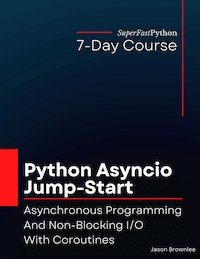We can retrieve return values from coroutines executed concurrently by asyncio.gather(). The asyncio.gather() function returns an asyncio.Future …
Asyncio gather() In The Background
We can run asyncio.gather() in the background by not awaiting the call to asyncio.gather(). The asyncio.gather() returns an asyncio.Future that …
Asyncio gather() Limit Concurrency
We can limit concurrency when using asyncio.gather() via a semaphore. In this tutorial, you will discover how to limit concurrency with …
Asyncio gather() Exception in Task Does Not Cancel
We can execute coroutines concurrently with asyncio.gather(). By default, an exception in asyncio.gather() will be propagated to the caller …
Continue Reading about Asyncio gather() Exception in Task Does Not Cancel →
Asyncio gather() Timeout
We can add a timeout when using asyncio.gather() via the asyncio.timeout() context manager. A timeout in seconds can be specified to the …
Asyncio Shield Main Coroutine From Cancellation
We can simulate shielding the main coroutine from cancellation by using a wrapper coroutine that consumes cancellation requests. In this tutorial, …
Continue Reading about Asyncio Shield Main Coroutine From Cancellation →
Asyncio Run Multiple Concurrent Event Loops
We can run multiple concurrent asyncio event loops by starting and running each new event loop in a separate thread. Each thread can host and …
Continue Reading about Asyncio Run Multiple Concurrent Event Loops →
Asyncio gather() TypeError: unhashable type: ‘list’
We can avoid a TypeError exception when using asyncio.gather() by unpacking the collection of awaitables with the star (*) operator. The …
Continue Reading about Asyncio gather() TypeError: unhashable type: ‘list’ →
Asyncio Event Loop in Separate Thread
We can run an asyncio event loop in a new thread by starting a new thread and configuring it to start or run an event loop. There are many …
Continue Reading about Asyncio Event Loop in Separate Thread →










